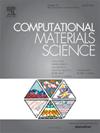IF 3.1
3区 材料科学
Q2 MATERIALS SCIENCE, MULTIDISCIPLINARY
引用次数: 0
摘要
本文分析了含有镁铝层状双氢氧化物(LDH)的环氧树脂复合材料的机械和损伤行为,这种复合材料具有作为防腐蚀涂层的潜在应用价值。对这些复合材料的分析是通过开发基于数值均质化方法的计算模型,并采用微机械有限元方法进行的。研究了 LDH 颗粒的弹性模量、长宽比和重量分数对环氧树脂/LDH 复合材料的机械和损伤行为的影响。对裂纹的形成和演变进行了损伤建模。观察到了由 LDH 颗粒引起的裂纹针刺和裂纹偏转等损伤机制。建模结果表明,随着 LDH 重量分数的增加,复合材料变得更硬、更脆。在环氧树脂中添加 5 wt% 的 LDH 颗粒可使复合材料的弹性模量增加近 20%。断裂应变降低到 2%。该模型根据实验数据进行了验证,证明了其预测环氧树脂/LDH 复合材料行为的能力。研究结果表明,环氧树脂/LDH 复合材料具有更高的刚度,适合作为防腐蚀涂层实际应用。本文章由计算机程序翻译,如有差异,请以英文原文为准。

Layered double hydroxides reinforced epoxy composites: Computational analysis of microstructure effect on strength
This paper analyses the mechanical and damage behaviour of epoxy composites incorporating magnesium–aluminium layered double hydroxides (LDH), which have potential applications as corrosion protective coatings. The analysis of these composites was carried out by developing a computational model based on numerical homogenisation approach, employing the micromechanical finite element method. The influence of the elastic modulus, aspect ratio and weight fractions of the LDH particles on the mechanical and damage behaviour of epoxy/LDH composites was investigated. Damage modelling was performed, capturing both crack formation and evolution. Damage mechanisms such as crack pinning and crack deflection due to the LDH particles were observed. The modelling demonstrated that with an increase in the weight fraction of LDH, the composite became stiffer and more brittle. Adding up to 5 wt% LDH particles to epoxy increased the elastic modulus of the composite by nearly 20%. The strain at break was reduced to 2 %. The model was validated against experimental data, demonstrating its ability to predict the behaviour of epoxy/LDH composites. The findings indicate that epoxy/LDH composites exhibit enhanced stiffness, making them suitable for practical applications as corrosion-protective coatings.
求助全文
通过发布文献求助,成功后即可免费获取论文全文。
去求助
来源期刊

Computational Materials Science
工程技术-材料科学:综合
CiteScore
6.50
自引率
6.10%
发文量
665
审稿时长
26 days
期刊介绍:
The goal of Computational Materials Science is to report on results that provide new or unique insights into, or significantly expand our understanding of, the properties of materials or phenomena associated with their design, synthesis, processing, characterization, and utilization. To be relevant to the journal, the results should be applied or applicable to specific material systems that are discussed within the submission.
 求助内容:
求助内容: 应助结果提醒方式:
应助结果提醒方式:


